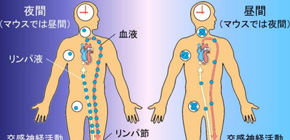
Mechanism behind diurnal variations in immune response by sympathetic nervous system elucidated
Vaccination during periods of strong immune response is effective
As it is often said that a fancy may kill or cure, it has been pointed out that the nervous system is involved in the control of the immune system. The sympathetic nerve system is an autonomic nerve system that controls the functions of various organs such as circulatory, respiratory, and digestive organs.
A group of researchers led by Specially Appointed Associate Professor SUZUKI Kazuhiro at the Immunology Frontier Research Center, Osaka University, had discovered how the sympathetic nerve system controlled lymph node (LN) entry and egress of lymphocytes; however, the role of this mechanism in immune responses was unknown. This research group clarified how the sympathetic nerve system generated diurnal variations in immune responses.
The sympathetic nerve system has diurnal variations, that is, sympathetic nerve activity increases during periods of high physical activity and decreases during periods of low physical activity. This group clarified in experiments using mice that the number of lymphocytes in LNs increased because lymphocyte egress from LNs was suppressed during periods of increased sympathetic nerve activity.
In this study, vaccination to mice during increased sympathetic nerve activity caused strong immune responses because of the increase of lymphocyte numbers in LNs, showing strong effects of vaccination. From this, it was clarified that the sympathetic nerve system's mechanism for controlling LN entry and egress of lymphocytes generated diurnal variations in immunity responses.
Regarding vaccine effectiveness, there is a big difference among individuals, which is a problem. Based on the results of this group’s study, it is expected that vaccination during periods of immune response enhanced by high sympathetic nerve activity, in the morning in case of humans, will bring about more stable effects.
Furthermore, the results of this group’s study give an interesting suggestion about the relationship between the nerve system and the immune system. The period of high sympathetic nerve activity is also the period of increased risk of being exposed to pathogens along with an increase in physical activity. Induction of stronger immune responses in LNs in such a period makes sense from the perspective of protection against infection.
Therefore, diurnal variations in immune responses by the sympathetic nerve system are thought to be one strategy for survival, which developed in the course of evolution in which the nerve system and the immune system interacted with each other. The understanding of diurnal variations in immune responses will make it possible to bring about the maximum preventive effects through vaccination during the period of strong immune responses.

Figure. Adrenergic control of adaptive immunity by diurnal lymphocyte trafficking. During the period of high adrenergic nerve activity, lymphocyte egress from LNs is restricted, which leads to an increase of lymphocyte numbers in LNs. Immunization during the period of lymphocyte accumulation in LNs promote adaptive immune responses. This diurnal variation of lymphocyte trafficking may have evolved to maximize the efficiency of host defense against pathogens.
To learn more about this research, please view the full research report entitled “ Adrenergic control of the adaptive immune response by diurnal lymphocyte recirculation through lymph nodes ” at this page of the The Journal of Experimental Medicine website.
Related link

